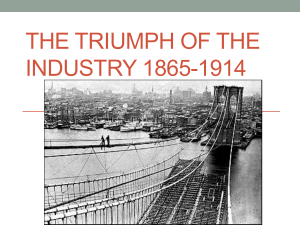12-18-10 APUSH page 464-477 KTs
advertisement
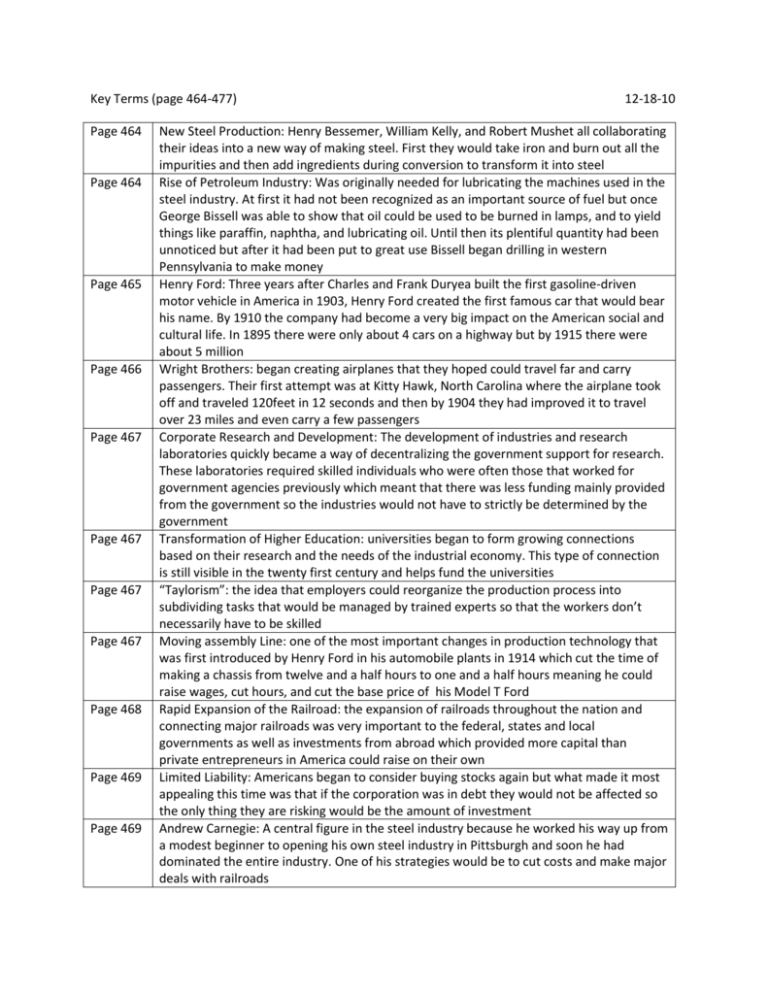
Key Terms (page 464-477) Page 464 Page 464 Page 465 Page 466 Page 467 Page 467 Page 467 Page 467 Page 468 Page 469 Page 469 12-18-10 New Steel Production: Henry Bessemer, William Kelly, and Robert Mushet all collaborating their ideas into a new way of making steel. First they would take iron and burn out all the impurities and then add ingredients during conversion to transform it into steel Rise of Petroleum Industry: Was originally needed for lubricating the machines used in the steel industry. At first it had not been recognized as an important source of fuel but once George Bissell was able to show that oil could be used to be burned in lamps, and to yield things like paraffin, naphtha, and lubricating oil. Until then its plentiful quantity had been unnoticed but after it had been put to great use Bissell began drilling in western Pennsylvania to make money Henry Ford: Three years after Charles and Frank Duryea built the first gasoline-driven motor vehicle in America in 1903, Henry Ford created the first famous car that would bear his name. By 1910 the company had become a very big impact on the American social and cultural life. In 1895 there were only about 4 cars on a highway but by 1915 there were about 5 million Wright Brothers: began creating airplanes that they hoped could travel far and carry passengers. Their first attempt was at Kitty Hawk, North Carolina where the airplane took off and traveled 120feet in 12 seconds and then by 1904 they had improved it to travel over 23 miles and even carry a few passengers Corporate Research and Development: The development of industries and research laboratories quickly became a way of decentralizing the government support for research. These laboratories required skilled individuals who were often those that worked for government agencies previously which meant that there was less funding mainly provided from the government so the industries would not have to strictly be determined by the government Transformation of Higher Education: universities began to form growing connections based on their research and the needs of the industrial economy. This type of connection is still visible in the twenty first century and helps fund the universities “Taylorism”: the idea that employers could reorganize the production process into subdividing tasks that would be managed by trained experts so that the workers don’t necessarily have to be skilled Moving assembly Line: one of the most important changes in production technology that was first introduced by Henry Ford in his automobile plants in 1914 which cut the time of making a chassis from twelve and a half hours to one and a half hours meaning he could raise wages, cut hours, and cut the base price of his Model T Ford Rapid Expansion of the Railroad: the expansion of railroads throughout the nation and connecting major railroads was very important to the federal, states and local governments as well as investments from abroad which provided more capital than private entrepreneurs in America could raise on their own Limited Liability: Americans began to consider buying stocks again but what made it most appealing this time was that if the corporation was in debt they would not be affected so the only thing they are risking would be the amount of investment Andrew Carnegie: A central figure in the steel industry because he worked his way up from a modest beginner to opening his own steel industry in Pittsburgh and soon he had dominated the entire industry. One of his strategies would be to cut costs and make major deals with railroads Page 470 Page 470 Page 471 Page 471 Page 471 Page 472 Page 473 Page 474 Page 475 Page 476 Page 476 Page 477 New Managerial Techniques: The structure of modern business administration had been created upon the idea of dividing the responsibilities carefully in a designed hierarchy which included many modern cost-accounting procedures and the “middle managers” which were the new executives in between the workers and owners Horizontal Integration: combining firms engaged in the same enterprise intoa single corporation Vertical Integration: taking over all different businesses where a company relied on its primary function Rockefeller’s Standard Oil: Rockefeller launched a refining company in Cleveland to immediately begin trying to eliminate his competition by trying to buy out his competing refineries and then finally in Ohio he formed the Standard oil Company The Trust Agreement: the trust agreement started with the Standard Oil Company and Banker J.P. Morgan. Under the trust agreement stockholders in individual corporations were transferred to stocks to a small group of trustees in exchange for shares in the trust itself. Rapid Corporate consolidation: due to corporate consolidation, one percent of the corporations in America were able to control more than 33 percent of the manufacturing industries, which created a system of organization that created power in the hands of many men like bankers and industrial titans Myth of Self-Made Man: The idea that some of the main industrial tycoons had started off in positions of wealth and power rather than what they claimed to be simply hard work Social Darwinism: application of Charles Darwin’s laws of natural selection and evolution among society, meaning that only the fittest survived in society and the fittest would flourish in the marketplace Russell Conwell: a Baptist minister who became a spokesperson for the idea of “Acres of Diamonds” where he told the story of people being able to find wealth in their own backyards Horatio Alger: one of the most famous promoters of the success story Lester Frank Ward: a Darwinist who rejected the application of the Darwinist Laws in Human Society. He argued that the civilizations was not governed by natural selection but human intelligence Henry George: A very influential radical who published Progress and Poverty in 1879 which became one of the best-selling nonfiction works in American publishing history Increasing Inequality: IN American society there were four fifths of the people who lived modestly and then at least 10 million people who lived below the commonly accepted poverty line

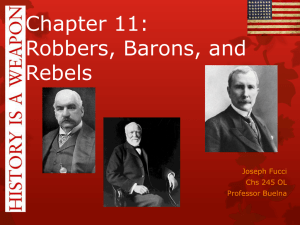
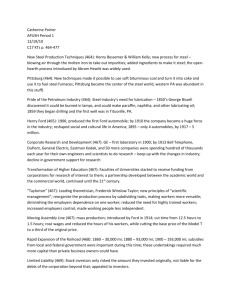
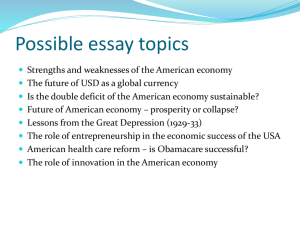
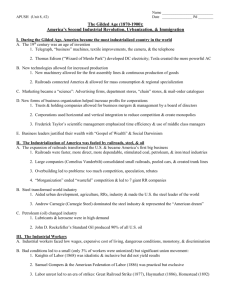

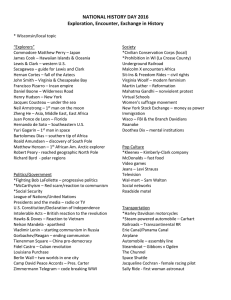
![men_who_built_america[1]](http://s2.studylib.net/store/data/005219845_1-7979604da89ac700f7913bb56611cc41-300x300.png)
